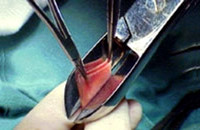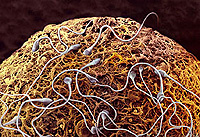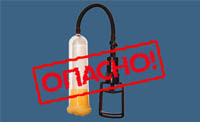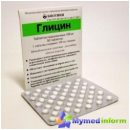What are the methods of treatment of phimosis? Is it possible to avoid the operation? What is the surgical treatment of phimosis? Answers you will find in this article.
Content
Treatment of pathological phimosis can be conservative (not surgical) and surgical (operational).
Not surgical treatment of phimosis
With hypertrophic phimosis (excess of extreme flesh preventing head removal), when there are no complications (repeated inflammations of extreme flesh, urination disorders), possibly conservative treatment, which consists in gradual stretching of the extreme flesh. Manipulation can be performed by parents at home. Three times a week during swimming with herbs champs (a series, chamomile), an extreme flesh displacement until the appearance of pain in a child, after which several drops of sterile vaseline oil is introduced into the pre-social space. Duration of treatment - several months. The procedure should be performed very carefully to avoid paraffimose. Success depends on the perseverance of parents and the severity of phimosis. In the presence of a scar zone narrowing conservative treatment, little effectively.
In recent years, the correction of phimosis is used by hormonal ointments, which are laid in the presence. They facilitate tensile fabric. Treatment is carried out by parents with the compulsory observation of the doctor.
In the absence of complications and coarse scarmets, the treatment of phimosis should be started with conservative measures that retain the extreme flesh with its protective, sensitive (sensory) and sexual function, and only with the failure of conservative treatment to resort to operation.
Operational treatment of phyhoshosis
Indications for surgery:
- pronounced changes of extreme flesh due to scars;
- repeated repetitions of balanopostitis (inflammation of the extreme flesh and genital head);
- Urination disorders.
The operation is carried out at any age, immediately after the diagnosis is established, in a planned manner,.E. With the full health of the child: the absence of infectious diseases in the last month before the operation and after the examination, if analyzes are normal.
 Most often circumcision of extreme flesh - Circumcia - circular excision of leaflets of extreme flesh. This operation lasts 10-15 minutes and, as a rule, is carried out under general anesthesia. Extreme flesh is cut off circularly (in a circle), with the preservation of the bridle. Internal and outer leaflets of extreme flesh are crossped by a ketguet (suture material, which is solicitated independently, and does not require the reversance of the seams). After the operation, the bandage with vaseline oil is superimposed. A few hours after surgery, the child can walk, restored independent urination.
Most often circumcision of extreme flesh - Circumcia - circular excision of leaflets of extreme flesh. This operation lasts 10-15 minutes and, as a rule, is carried out under general anesthesia. Extreme flesh is cut off circularly (in a circle), with the preservation of the bridle. Internal and outer leaflets of extreme flesh are crossped by a ketguet (suture material, which is solicitated independently, and does not require the reversance of the seams). After the operation, the bandage with vaseline oil is superimposed. A few hours after surgery, the child can walk, restored independent urination.
In some countries, the so-called hygienic circumcision is quite popular - removal of healthy extreme flesh, in order to avoid, as supporters of the procedure, possible in the future complications (penis cancer, venereal diseases, inflammation of the extreme flesh, etc.). Parents should be aware that there is not a single medical, confirmed testimony for prophylactic circumcision, which the American Academy of Pediatrics made a decision in 1975.
Complications after the operation made in the hospital conditions an experimental surgeon rarely and do not exceed 0.1-0.2%. If they still appear, they are divided into sharp (bleeding, acute urine delay, the suppuration of the postoperative wound) arising immediately after the operation and chronic. Bleeding occurs with poorly performed crosslinking damaged during the excision of the foreskin, blood vessels (especially often such a complication is observed when the operation is performed at home in religious purposes) and with non-revealed blood coagulation diseases. In most cases, it is enough to stop bleeding enough imposition of a dense bandage for postoperative seam. With continuing bleeding, it is necessary to impose seams on a bleeding vessel.
The chronic complications include MEATIIT (inflammation of the Meatos - the outdoor opening of the completion), metalosenosis (narrowing the outer opening of the urethra), excessive leaving of the extreme flesh.
After the operation, the mucous membrane of the outer opening of the urethra is deprived of the protection of the extreme flesh, as a result of which its local inflammation can occur - MEAATIIT. This complication is characterized by redness of Meatos, sometimes painful urination, changes in urine tests indicating inflammation. Treatment: Baths with a solution of manganese and antibacterial drugs most effective in the treatment of infections of the urinary system (for the purpose of the doctor).
As a result of the inflammation of Meatus, its scarsing narrowing can develop - meatostenosis, when urination is produced by a thin jet, with a fitting, for a long time. The diagnosis is confirmed by examining a urologist-an andrologist with a hubblerummetry, a special study determining the flow rate of urine. For a child, this procedure is no different from conventional urination, only in a special toilet connected to a computer. Matosostation requires surgical treatment - dissection or formation of the right contours of the outer hole of the urethra (plastic of Meatus).
Excessive leaving of the extreme flesh is diagnosed when there are uneven flap of excessively left by an extreme flesh surgeon. In this case, the repeated circumcision is shown to achieve a cosmetic effect. Sometimes, especially if the extreme flesh is redundant throughout the circumference, recurrence of phimosis is possible. At the request of parents, plastic of the extreme flesh can be carried out. In this case, the narrowing is eliminated, but most of the extreme flesh is preserved. This operation is somewhat more complicated technically and is accompanied by a large number of complications (mainly recurrent phimosis).
Some peromalies for the development of the penis
Even before circumcision of the extreme flesh, the surgeon must be convinced of the correct location of Meatos - on the top of the penis head. If the outdoor hole is detected - hypospadia (congenital disease, it is found in 1 of 150 boys), the cutting operation of the extreme flesh is not carried out, as it is first necessary to resolve the issue of the tactics of the surgical treatment of hypospadias.
Often phimosis is combined with a short bridle of the foreskin, which deforms the Meatus and twists the head of the penis. In this case, simultaneously with Circumcision, dissection and plastic of the bridle.









